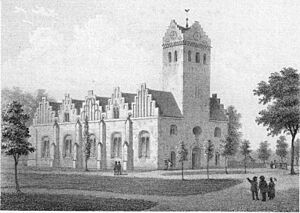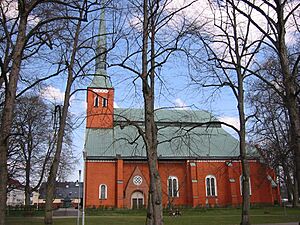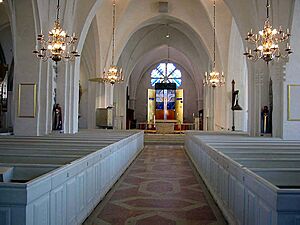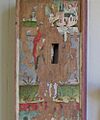Växjö Cathedral facts for kids
Quick facts for kids Växjö Cathedral |
|
|---|---|
| Växjö domkyrka | |
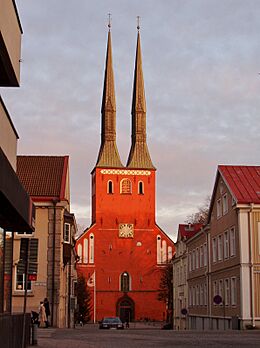
The west facade of Växjö Cathedral
|
|
| 56°52′39″N 14°48′43″E / 56.87750°N 14.81194°E | |
| Location | Växjö |
| Country | Sweden |
| Denomination | Church of Sweden |
| Previous denomination | Roman Catholic Church |
| Website | Official site: https://www.svenskakyrkan.se/vaxjo/vaxjo-domkyrka- |
| History | |
| Founded | 11th century (probable wooden predecessor) 1160s (first stone church) |
| Founder(s) | Sigfrid of Sweden (legendary) |
| Architecture | |
| Functional status | Active |
| Heritage designation | Listed in the buildings database of the Swedish National Heritage Board. |
| Architect(s) | Carl Georg Brunius Carl Möller Kurt von Schmalensee |
| Administration | |
| Diocese | Diocese of Växjö |
Växjö Cathedral (Swedish: Växjö domkyrka) is a beautiful and historic church located in Växjö, Sweden. It is the main church for the Diocese of Växjö, which is part of the Church of Sweden. Imagine a church that has stood for hundreds of years, changing and growing with time!
Legend says that Saint Sigfrid, a missionary from England, founded the cathedral. The very first stone church here was built around the 1160s. Parts of that old church are still inside the cathedral you see today. Over the years, the cathedral has been changed many times. Its current look is mostly thanks to a big restoration project in the 1950s. This project was led by architect Kurt von Schmalensee.
Växjö Cathedral is a special type of church called a hall church. This means its main area and side sections are all the same height. It has a tall tower at the west end and a square choir (the area where the clergy and choir sit). The church was built in a spot that might have been a marketplace long ago, even before Christianity came to Sweden. Most of the art and decorations you see inside today are from the 20th or 21st centuries. Many of these beautiful pieces are made of glass!
Contents
History of Växjö Cathedral
Early Beginnings: Middle Ages
The story of Saint Sigfrid tells us that he was a missionary from England. He supposedly chose Växjö as the place to build a cathedral. The legend also says he was buried there. While this story might not be completely true, it is likely that a wooden church stood on this spot in the 11th century. This was during the time when Christianity was spreading in Scandinavia.
Archaeologists have found 11th-century coins inside the church. Also, a Christian runestone from the same century (called Sm 10) is next to the choir wall. These findings suggest that an early wooden church was indeed here.
The Diocese of Växjö was created in the late 1160s. Building a stone church probably started around the same time. The stone church was likely built around the wooden one. This way, the wooden church could still be used while the new stone building went up. During a big restoration in 1957–58, the foundations of this first stone church were found. It had a nave (the main part of the church) and a narrower choir with a rounded end. A tower was added a bit later. This early church looked similar to Lund Cathedral and Rydaholm Church. It held the relics of Saint Sigfrid. During the Middle Ages, the church was dedicated to Saint Sigfrid and John the Baptist.
The cathedral's tower was damaged by fire in the late 1200s. This might have happened during a conflict between King Valdemar and his brother Magnus in 1276. The tower was probably used as a fort during the fighting. King Valdemar later gave money to help rebuild it. The choir and its rounded end were also rebuilt into a square choir and a transept (a part of the church that crosses the main body). This likely happened when a proper cathedral chapter (a group of clergy) was set up in Växjö. A sacristy (a room for church items) was added in the early 1300s. It was robbed in 1318, so we know it existed then.
During the first half of the 1300s, a chapel was added to the south side. Two transepts were also built in the same century. All this building activity happened as Växjö town grew. The town received town privileges in the 1300s. By the end of the century, the cathedral looked a bit uneven because of all these additions.
Big changes happened in the 1400s. The different parts of the church were joined into one large space, making it a hall church. The tower was made taller and might have had two spires. A church porch was added to the north entrance, and a new chapel was built to the south. Inside, new vaults were built to support the ceiling. These vaults were similar to those found in Vadstena Abbey. An old inscription said the vaults were finished in 1509 by a mason from Linköping. These changes probably took place between 1460 and 1500. A special chapel for prayers was also added in the 1400s.
Changes After the Reformation
After the Reformation in Sweden, Växjö Cathedral became a Lutheran church. It lost many of its old ways of getting money. In 1570, Danish soldiers attacked Växjö. They looted and burned the church during the Northern Seven Years' War. King John III of Sweden gave the people of Växjö a break from taxes for three years. This was so they could afford to fix the cathedral. Still, repairs took six years, and the tower was not fully fixed until 1585. During these repairs, the church's spires were changed. A mechanical clock was also put on the west side of the church. By the end of the 1500s, the cathedral looked much like it does today.
In 1612, Danish troops came to Växjö again. They used the cathedral as their living quarters. During this time, the pews (church benches) were destroyed, and the church's old records were burned. In 1629, a storm damaged the spires, and they had to be replaced again.
In 1740, lightning struck one of the spires, causing another terrible fire. The entire roof and the top of the tower were destroyed. The vaults in the east part of the church also collapsed. Any remaining medieval furnishings were lost. Repairs began in 1741 and continued into the 1770s. The old medieval roof was not rebuilt. Instead, a hipped roof (a roof that slopes on all sides) was put in. The two spires were replaced with a single tower in a Classical style. This new tower was designed by Carl Hårleman.
Changes by Carl Georg Brunius and Carl Möller
After several fires in Växjö in the late 1700s and early 1800s, people worried about the cathedral's safety. The roof was especially at risk. The bishop, Esaias Tegnér, and the governor decided to hire architect Carl Georg Brunius. He was asked to create plans for a reconstruction. Brunius suggested a big change to the outside of the church. He wanted to put the nave and choir under a low roof. He also wanted to replace the roof over the aisles with several angled roofs. These would end in stepped gables (stair-like roof edges). The tower and choir would also get stepped gables. This design was inspired by German churches. Even though some government officials disagreed, Brunius's plans were mostly carried out. The cathedral was rebuilt between 1849 and 1854. More repairs and small changes were made in the 1860s and 1880s.
More big changes happened in 1898–99. The inside of the church was redecorated by architect Carl Möller. A new sacristy was built, a new clock was installed, and stained glass windows were added. All the walls and vaults were painted with murals (large paintings). New Gothic Revival style pews, choir stalls, an altarpiece, and an altar rail were made. Local artists created these pieces following Möller's designs. The new interior made the cathedral look consistently medieval.
Renovation in the 1950s
Brunius had predicted his renovation would last 100 years, and he was right! By 1940, the church needed repairs again. An initial plan was made to fix the roof and walls and add a new heating system. After the first architect passed away, Kurt von Schmalensee took over. He suggested a more complete reconstruction, which was approved in 1958.
Between 1958 and 1960, the cathedral was largely rebuilt. The goal was to bring back some of its earlier, medieval look. New floors were laid, and the walls and vaults were strengthened. A new south entrance was built, windows were changed, and the tower was altered. Two new spires were added to the tower. The outside of the church was painted red. Traces of this red color had been found during wall repairs. This reconstruction was seen as a great success at the time. Smaller repairs were also done in the late 1900s.
Location and Surroundings
Växjö Cathedral is located at the edge of the oldest part of Växjö town. When the cathedral was first built, its south side was less than 20 meters (about 22 yards) from the shore of Växjö Lake. It's possible this was a marketplace in ancient times. The cathedral's low location might have been chosen to be near a popular gathering spot.
Over the years, water control projects in the 1700s and 1800s moved the lake shore much further away. Now, the cathedral stands in a park that was created in 1879. From the Middle Ages until the 1800s, many church-related buildings surrounded the cathedral. Today, only the old home of the cathedral school remains, dating from the 1600s.
In the park, where a cemetery used to be, there is a bronze statue of Bishop Esaias Tegnér. This statue was made in 1926 by sculptor Arvid Källström. It is located north of the cathedral, between the church and the old school. In front of the cathedral, there is a statue of Saint Sigfrid. It was put there in 1999 and designed by sculptor Peter Linde.
Architecture and Design
The oldest parts of the current building are the base of the tower and the pillars inside the main area. These parts include building materials from the 1100s. The upper walls of the tower are mostly from the end of the Middle Ages. However, the tower's look has changed a lot over the centuries. North of the tower is an addition from the 1750s, while the south part of the tower is medieval. The choir walls are also medieval, from a larger choir built in the 1200s. The easternmost parts of both side sections are from 1849 to 1850. The south annex to the choir was built as a sacristy in 1898–99.
The outside of the cathedral is mostly painted red. The stone around the windows and other stone parts are painted white. The building has a main area (nave) with two side sections (aisles). It has a wide western tower and a square choir. The large windows on the south and north walls are from Brunius's reconstruction. The west side of the church has decorative arches from the 1950s restoration. The tower has two tall spires and nine openings for bells. The main entrance is at the base of the tower on the west side. Its current look is from the mid-1800s. The copper doors and the decorative window above the doorway are from the 1950s. A second entrance, built in the 1950s, is on the south wall. A single copper roof covers the nave, aisles, and choir.
Inside the Cathedral: Art and Furnishings
Växjö Cathedral is a hall church, meaning its nave and aisles are all the same height. It has three sections wide and four sections long. The inside is painted white and is brightly lit by windows of similar size. All but one of these windows are from the 1950s renovation. The ceiling is supported by 13 vaults, and 7 of them are medieval. The oldest vaults are mostly in the western part of the church. Traces of medieval murals have been restored in the southwest corner, which used to be a special prayer chapel.
Inside the main entrance, there is a glass windbreak with doors decorated by artist Irene Jarz. These were installed in 1996. The entrance also has an 18th-century memorial stone with a short history of the cathedral. Above the doorway to the main church area, there is a stucco relief (a raised plaster artwork) of Christ giving a blessing, made by artist Kajsa Mattas.
Inside the nave, a stone marker with a stylized "S" and three crosses is on the floor. This marks the spot where Saint Sigfrid's body was likely buried. The current altarpiece (the artwork behind the altar) was installed in 2002. It is made of glass and designed by glass artist Bertil Vallien. An older altar painting from 1733 hangs in the north aisle. The baptismal font is also a glass artwork by artist Göran Wärff. Another glass art piece is a candle holder near the entrance, made by Erik Höglund with metal parts by Lars Larsson. The pulpit (where sermons are given) and the former baptismal font were made by Jan Brazda during the 1950s restoration.
The former prayer chapel is separated by glass doors, also decorated by Irene Jarz. It contains an altar and cross by Jan Brazda. There are also two stained glass windows designed by Bo Beskow in this chapel. The church chandeliers are from different time periods. In the western parts of both aisles, there are Gothic Revival chandeliers. These were probably given by opera singer Christina Nilsson. In the nave, there are two wooden sculptures from the 1900s. They show Saint Peter and Saint Paul, created by sculptor Eva Spångberg.
The cathedral has a carillon (a set of bells played like an instrument) installed in 1962. It has 27 bells. The cathedral also has five large church bells.
Växjö Cathedral has three church organs. The largest organ has a front part made in the 1770s, but its inner workings are from 2002. Two smaller organs are in the north aisle (from 1984) and the south aisle (from 2001).
Use and Heritage Status
Växjö Cathedral is the main church for the Bishop of Växjö within the Church of Sweden. It also serves as a local parish church for the Växjö area. The cathedral holds regular church services and is also used for concerts. It is recognized as a listed building by the Swedish National Heritage Board. This means it is a protected historical site.
Images for kids
See also
 In Spanish: Catedral de Växjö para niños
In Spanish: Catedral de Växjö para niños



